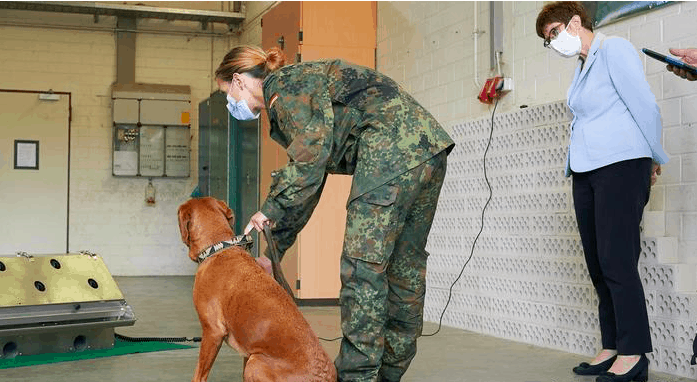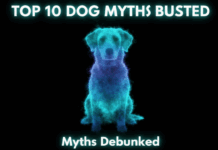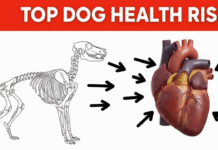Last Updated on January 21, 2021 by Dogs Vets
Facts About Your dog’s sense of smell
Humans have known for millennia that a dog’s sense of smell is quite different from ours. But science has recently come up with all sorts of wow-worthy information about how our dogs smell. Check out seven of the latest and greatest findings about a dog’s sense of smell.
Fortunately, research into canine cognition can help unravel their minds and provide insight into what they need to live psychologically fulfilled and happy lives.
Dogs are familiar, yet fascinatingly strange. To appreciate their “otherness,” all you have to do is look at their sensory world.
My dogs and I have very different experiences when we walk a trail. I marvel at the beautiful fall day, but my dogs have their heads to the ground and seem oblivious to the wonders around them.
But they appreciate something I can’t: the smell of the fox that scampered through last night, the lingering scent of the dogs that have walked this trail, and the footsteps of my neighbor who last wore her hiking boots in the woods My dogs have never visited.
You’ve probably heard of dogs that sniff out cancer, guns, or even coronavirus. These dogs are not special in their nose power: your dog could do the same.
See also: Top 10 best dog breeds for seniors in 2021
The first dog to sniff cancer sniffed a mole on her owner’s leg so frequently thathow is a dogs sense of smell useful to man she went to the dermatologist, where she was diagnosed with melanoma.
A dog’s sense of smell is estimated to be 10,000 to 100,000 times better than a human’s. This is due in large part to amazing differences in how humans and dogs process smell.

While we have about 6 million olfactory receptors, dogs have an astounding 300 million. Their epithelium, or nasal tissue, is about 30 times larger than ours. And while humans have between 12 and 40 million olfactory neurons – specialized cells involved in transmitting olfactory information to the brain – dogs can have 220 to 2 billion, depending on their breed.
Why do dogs sniff so much?
It’s very easy to ignore what we don’t understand, but part of living with a dog is realizing that a dog’s sense of smell is important to them in many ways. First of all, it’s fun. Just as we look around and enjoy it, our dogs sniff and equally enjoy it. Second, it’s a way to find out what environment (and who) it might contain – and if it’s safe. And they gather information left by other dogs (check their little mails!) – and they process all this ever-changing information about the area and its inhabitants, while we think they’re just wasting time sniffing.
Sniffing has so many advantages and benefits to your dog
As owners, we need to give our dogs time to sniff. Most of us know that five minutes of exercise will tire our dog out to an hour of physical activity, but we don’t always realize that five minutes of sniffing does the same thing. It’s not just their noses that are working, it’s a large part of their brains as well. For active dogs, or for dogs that start their walks completely out of control, either pulling on the leash with excitement or darting all over the place, spending time sniffing can relieve their unfocused energy.
For anxious reactive dogs, sniffing can help them feel safer – having spent time figuring out what’s out there and whether to worry or whether it’s far more likely to be safe.
See also: Can dogs eat rice? Top 6 facts about feeding rice to your dog
Perhaps more importantly, for all dogs, the opportunity to sniff fulfills a lot of their sensory needs – as much as physical exercise, mental exercise, and as much as play. Sniffing makes them happy and gives them an outlet for their hard-wired natural behaviors. So often we ignore this important part of our dogs’ needs because we just don’t understand it.
How can a dog’s sense of smell help people?
We all know that dogs have a strong sense of smell, but what does that mean for us? Dogs can help humans track and identify all kinds of things that make our lives better!
- Rabbits, foxes, birds and other quarries for hunters.
- Lawbreakers on the run
- Cancer and infectious diseases
- Drugs
- Falling glucose levels in their owners
- Traces of peanuts in food
- Bed bugs
- Drugs and contraband
- Missing persons
- Bombs and other explosives
- Signs of arson
Here are the Top 7 Shocking Facts About Your dog’s sense of smell
1. Dogs sense of smell is much stronger than any of ours.
Yes, you can think of two ways to read this, but think of how your dog smells when wet and you will figure out the correct meaning. When it comes to nose sensitivity, dogs are the winners of paw prints over humans. There are many numbers on how much better a dog’s sense of smell is than ours. There are so many variables that quantification is almost impossible.
I have seen numbers that indicate a dog’s sense of smell is 10 to 100 to 1,000 to 1,000,000 times better. Scientists I’ve talked to say that dogs can detect some, if not most, odors in parts-per-trillion concentrations.
Psychologist and prolific dog book author Stanley Coren gave me an example of what this great sensitivity of the sniffer looks like. Let’s say you have one gram of a component of human sweat known as butyric acid. Surprisingly, people can smell this pretty well. If you let it evaporate in the space of a 10-story building, many of us can still detect a faint odor when we enter the building.
Not bad for a human nose. But consider this: If you put the 135-square-mile city of Philadelphia under a 300-foot-high enclosure, vaporize the gram of butyric acid, and let a dog in, the average dog can still detect the odor.
2. To a canine, you stink.
No matter how clean you are and no matter how much soap, perfume and deodorant you wear, you still smell great to your dog. Every human has a unique scent fingerprint and that’s pretty much all a dog needs to distinguish one person from another. “To our dogs, we are our scent,” says Alexandra Horowitz, an expert in canine cognition, author of the insightful book Inside of a Dog: What Dogs See, Smell, and Know. In the book, she writes this wonderful description about a dog’s sense of smell:
“Humans stink. The underarm of a human is one of the deepest sources of odor produced by an animal. our breath is a confusing melody of smells; our genitals stink. The organ that covers our body – our skin – is itself covered with sweat and sebaceous glands that regularly produce fluids and oils that contain our particular scent mark.
When we touch objects, we leave a bit of ourselves on them; a piece of skin whose bacterial clutch is constantly chewing and excreting. This is our smell, our distinctive scent. “
3. A dog’s sense of smell picks up all sorts of unseen things.
With every step you take, you shed a lot of dander – much like the Peanuts character Pigpen and his ubiquitous cloud of dirt. Real people have the same woge, only it’s made up of skin cells, which in this flake form are called rafts or scabs.
Preserve this: We lose 50 million skin cells per minute. Impressive. “They fall like microscopic snowflakes,” Coren says. I’m sitting here just moving my fingers on my keyboard because I really don’t want to shed, but no matter what I do, I’m just a blizzard. Fortunately, we can’t see this winter wonderland ourselves. But these rafts and scabs with their biological richness, including the bacteria that deposit with them, are very “visible” to the nose of dogs.
4. You cannot fool your dog’s sense of smell.
Research shows that it is very likely that a dog’s sense of smell can pick up fear, anxiety and even sadness. The flight or fight hormone adrenaline is undetectable in our noses, but dogs can apparently smell it. In addition, anxiety or fear is often accompanied by increased heart rate and blood flow, which allows telltale body chemicals to reach the surface of the skin more quickly. Trying to mask your strong feelings with a casual smile may fool your friends, but it won’t fool a dog’s sense of smell.
5. Dogs use their scent to send messages by peeing.
I love this outline of dog communications from Coren: “Dogs read about the world through their noses and write their messages, at least to other dogs, in their urine.” It’s tempting to take your dog on a walk when he’s sniffing everything annoyingly slow, but give him the opportunity to read the neighborhood gossip column and let him write a little while he’s at it.
6. This is what happens when dogs smell each other’s under-regions.
When dogs start sniffing each other’s under- regions, they probably learn a lot more about each other than you and the other dog’s owner do through idle chit-chat. Exactly what dogs learn and what they do with that information is still for science to figure out. But it’s very likely way beyond “Nice weather we’re having, huh?” It’s probably more like, “Oh, you’re a nice dog, and you’ve had chicken recently and you’re about 10 years old?”
7. Scientists study dogs’ noses like never before
Perhaps it’s because of dogs’ role in the military as unparalleled IED detectors. (You can learn much more about how dogs do their jobs in the military on youtube). Or maybe dog noses and a dog’s sense of smell are so amazing, and the more we know, the more we want to know. A dog’s sense of smell is more studied than ever at universities around the world.
FAQ
Can dogs detect the coronavirus?
As the COVID-19 pandemic has continued to spread, early identification of SARS-CoV-2 infected individuals is critical to breaking the chains of infection. Volatile organic compounds produced by respiratory infections can cause specific odor casts that can be detected with high precision by trained dogs.
Their Methods
8 detection dogs were trained for 1 week to detect salivary or tracheobronchial secretions from SARS-CoV-2-infected patients in a randomized, double-blind, controlled trial.
Finland researchers say their canine sniffers can detect COVID-19 quickly and inexpensively, but so far their capabilities are hardly being used to combat the pandemic.
Covid-19 dogs started their work today at the Helsinki Airport at arrival hall 2B. Dogs have been trained to detect the coronavirus from the test wipes given by the testperson. Service is voluntary and primarily targeted for passengers arriving from abroad. pic.twitter.com/ieMLm0KuZY
— Helsinki Airport (@HelsinkiAirport) September 22, 2020
No human nose needed
A canine can smell a piece of cloth wiped on the wrist or neck of an infected patient and instantly determine if it came from someone who contracted the virus up to five days before symptoms appeared that would lead to a person being isolated.
“One dog could so easily save so many lives,” University of Helsinki veterinary researcher Anna Hielm-Bjorkman told DW, saying her tests have shown an accuracy of nearly 100%.

Conclusion on Your dog’s sense of smell
Dogs have an amazing sense of smell and can be very useful in everyday life..Learning to understand your dog’s mind can not only satisfy your curiosity about your companion, but also help your pup live a good and happy life. The more you know about your furry friends, the more you can do to fulfill their needs.
Read also: Top 10 best dog breeds for seniors in 2021
Fact Check
We strive to provide the latest valuable information for pet lovers with accuracy and fairness. If you would like to add to this post or advertise with us, don’t hesitate reach us. If you see something that doesn’t look right, contact us!
Reference: Washingtonpost and Dogster

















